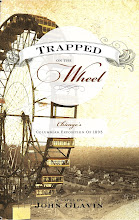
What was the fate of the Ferris Wheel after the World's Fair closed?
Well, sorting the false leads from the facts is fun, so here comes the skinny:
The fair closed officially on Oct. 28, 1893, early because of the assassination of Mayor Carter Harrison. However, the wheel proved to be a moneymaker so it continued to spin until April of '94. Dismemberment was finished on July 23. After being loaded aboard railroad cars the wheel was stored at the 61st Street siding of the Illinois Central Railroad in Woodlawn.
In early '95, the Ferris Wheel was reassembled on north Clark Street near Lincoln Park. However, two facts doomed its success: the national depression worsened and few patrons were willing to pay 50 cents, the same amount charged earlier at the fair. Also a lawsuit tried to cancel the building permit, and the city refused a liquor license so that plans for a roof garden nearby was canceled.
The following year the Ferris Wheel Company declared bankruptcy. Besides the woeful fate of his beloved wheel, his financial debts, his being forced out of his own company, George Ferris also had separated from his wife after a childless and failed marriage. To make matters worse, on November 22, 1896, at the age of 37 George Washington Gale Ferris, Jr. died of typhoid fever.
A year after his premature death, his ashes were still held by the undertaker in Pittsburgh because of unpaid funeral bills.
In 1900, plans were made to dismantle the wheel a second time after losing $700,000. Bids were entertained by the Chicago Tribune. A deal to move it to Berlin fell through so the wheel revolved another three years. At that time a wrecking company tried to acquire the wheel for $1800 to reduce it to junk.
Three days later, another wrecking company outbid it for $5,150 and allowed it to function for the rest of the season through 1903. During that winter the wheel was again dismantled and placed on railroad cars for a trip to the St. Louis World's Fair. Upon its reconstruction Mr. Bennett the superintendent proclaimed, "from an engineering point of view the wheel is now in much better condition that before its removal. The rods and other members have been adjusted with such accuracy that the wheel runs with a variation of not more than 1/6 inch, diametrically." Go figure.
Whereupon, the wheel proceeded to do even more business than at the Chicago Fair which grossed almost $800,000. After the St. Louis Louisiana Purchase Exposition closed the salvage rights to the wheel were sold. Finally after filling 60 rail cars each day for weeks, dynamite (200 pounds) exploded its supports.
The giant Ferris Wheel slowly collapsed upon itself like a battered dinosaur.





No comments:
Post a Comment